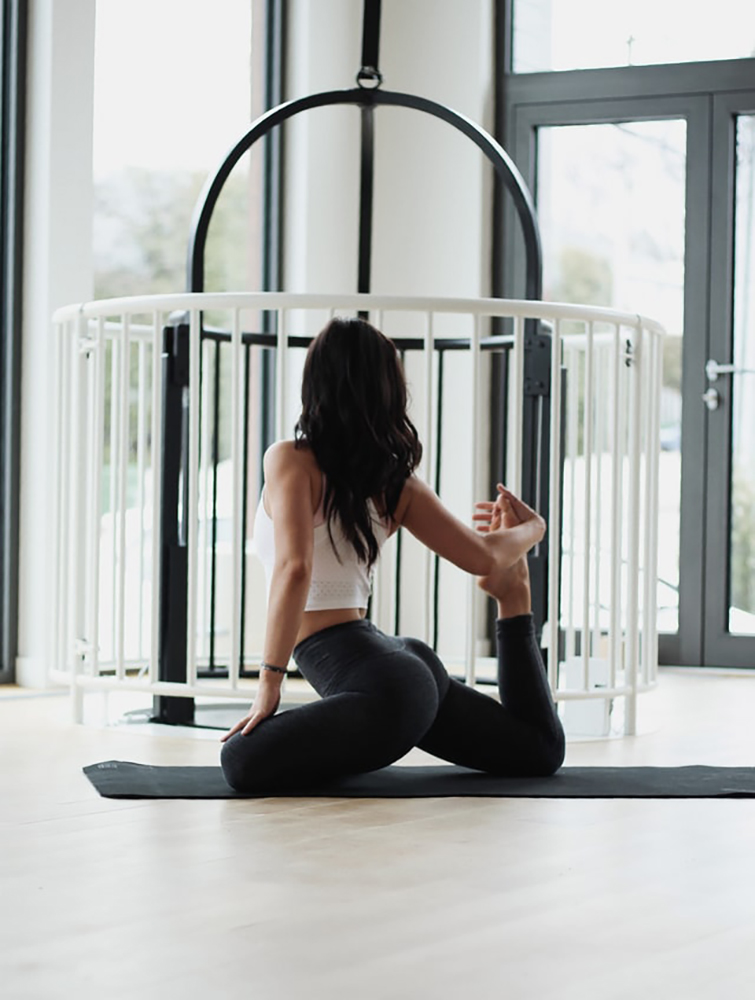


Back pain, whether acute or chronic, can be emotionally and physically debilitating. Musculoskeletal conditions are the leading contributor to disability worldwide, with low back pain being the single leading cause of disability in 160 countries. Sciatica is one of the most common yet highly misunderstood types of back pain. Shockingly, as many as 40% of individuals will experience it in their lifetime, and just like most things, it becomes more frequent as we age. Before you feel completely overwhelmed and anxious, know that there are tons of ways to manage these flares. So let’s get into it.
What is Sciatica?:
Sciatica refers to pain caused by the sciatic nerve that carries messages from the brain down the spinal cord to the legs. This nerve branches from your lower back through your hips and buttocks and down each leg. However, sciatica typically only affects one side of your body.
The sciatic nerve runs through the piriformis, a tiny yet influential muscle deep in your glutes that helps laterally rotate your hips. If it gets too tight, it can impact the sciatic nerve that runs through or under it, causing excruciating pain, numbness, and tingling in your lower extremities. Sciatica can occur from several conditions that affect your spine and can affect the nerves running along your back. It can also perpetuate from overly tight hips or an injury like a herniated disc.
Though mild sciatica typically goes away with time, always contact your medical care team if your symptoms persist. Working with a physical therapist, along with daily stretching, and using hot and cold therapy is one of the best remedies for this type of pain. Below you will find five stretches that help open the hips while taking pressure off the lower back. When done daily, these will help bring some much-needed relief. Try pairing these stretches with anxiety-relieving aromatherapy to make this practice even more impactful.
5 Simple Yoga Poses for Sciatica:
1. Cobra Pose (Bhujangasana)
By providing an opening in the chest and a stretch in the shoulders, Cobra Pose is a type of backbend that fights fatigue, relieves lower back pain, and improves spinal mobility. It helps allow a deep stretch to the chest, lungs, shoulder, and abdomen while soothing stress and sciatic pain. Lie on your stomach and spread both hands flat on the floor under your shoulders, hugging elbows in. Pressing your lower body into the floor, inhale and begin lifting your torso. Drop your shoulders away from your ears, lift through the chest, and send your gaze upward. Relax the lower back and keep the back of your neck long. Hold this pose for 6-10 breaths. For a demonstration, please see here.
2. Reclined Pigeon Pose (Supta Kapotasana)
This pose allows you to stretch the glutes, piriformis, external hip rotators, hamstrings, and knees. It can help ease and release lower back tension, sciatica, and piriformis syndrome. To perform, lie on your back with your knees bent, feet flat on the mat, hip-width apart. Then, rest your right ankle on top of your left knee. Inhale, pause, and on your exhalation, thread your right hand through the triangle between your legs and hold the back of your left thigh with both hands. Gently pull your leg towards you and press the back of your pelvis into the mat to subtly increase the resistance of the pose. Hold this pose for 5-10 breaths and continue on the other side. For a demonstration, please see here.
3. Self-Trigger Point Therapy
Using a tennis or lacrosse ball can be highly effective at delivering sciatica pain relief. To try, find a painful spot, place the ball at the location and then relax your body into the ball. Hold this position for 30-60 seconds and move on to the next painful area. For a demonstration, please see here .
4. One-Legged Seated Spinal Twist Pose (Marichyasana)
A simple seated spinal twist can help relieve built-up tension in your neck, shoulders, and lower back. Begin seated on your mat with your legs extended straight out in front of you. Bend your right leg over your straightened left leg. Hug your right knee with your left arm, making sure to keep your back straight. Hold this pose for 30-60 seconds, making sure to repeat on the opposite side. For a demonstration, please see here.
5. Happy Baby (Ananda Balasana)
Happy Baby is an excellent pose to end in that helps take pressure off the sciatic nerve. To get into this posture, lie on your back, and with an exhale, bend your knees into your belly. Inhale, grip the outsides of your feet with your hands. Open knees slightly wider than your torso, then bring them up towards your armpits. Then position each ankle directly over the knee, ensuring your shins are perpendicular to the floor. Flex through the heels and gently push your feet into your hands as you pull your hands down to create resistance. For a demonstration, please see here.
Related Stories:
Your Guide To All Things Stretching
Here’s Your Guide On Hot Versus Cold Therapy For Sore Muscles
5 Essential Oils To Soothe Your Anxiety, According To An Aromatherapist
Disclaimer:
Please remember to always consult with your physician before attempting any new exercise. No content on this site should ever be used in place of direct medical advice from your doctor or other qualified clinicians.
腰痛は、急性であろうと慢性であろうと、感情的および肉体的に衰弱をもたらす可能性があります。 筋骨格系の状態は、世界中の障害の主な原因であり、160か国で腰痛が障害の主な原因の1つです。 坐骨神経痛は、最も一般的であるが非常に誤解されているタイプの腰痛の1つです。 驚いたことに、40%もの人が一生のうちにそれを経験し、ほとんどの場合年をとるにつれてさらに頻繁に体験しています。不安を感じる前に、 これらを管理する方法はたくさんあることを知ってください。 それでは、始めましょう。
坐骨神経痛とは?:
坐骨神経痛は、脳から脊髄を下って脚にメッセージを運ぶ坐骨神経によって引き起こされる痛みを指します。 この神経は腰から腰と臀部を通って各脚に分岐します。 ただし、坐骨神経痛は通常、体の片側にのみ影響します。
坐骨神経は梨状筋を通り抜けます。梨状筋は、臀筋の奥深くにある小さいながらも影響力のある筋肉で、腰を横方向に回転させるのに役立ちます。 きつすぎると、その中または下を通る坐骨神経に影響を与え、耐え難いほどの痛み、しびれ、下肢のうずきを引き起こす可能性があります。 坐骨神経痛は、脊椎に影響を及ぼし、背中に沿って走る神経に影響を与える可能性のあるいくつかの状態から発生する可能性があります。 また、過度にタイトな腰や椎間板ヘルニアのような怪我からも永続する可能性があります。
軽度の坐骨神経痛は通常、時間とともに消えますが、症状が続く場合は必ず医療チームに連絡してください。 理学療法士と協力し、毎日のストレッチ、および温冷療法の使用は、このタイプの最良の治療法の1つです。以下に、腰を圧迫しながら腰を開くのに役立つ5つのストレッチがあります。 毎日行うと、これらは切望されていた救済をもたらすのに役立ちます。 これらのストレッチで不安を和らげるアロマテラピーと組み合わせてみてください。この慣行をさらに影響力のあるものにするためです。
坐骨神経痛のための5つの簡単なヨガのポーズ:
1. コブラポーズ(ブジャンガサナ)
コブラポーズは、胸に開口部を設け、肩にストレッチを施すことで、倦怠感を和らげ、腰痛を和らげ、脊椎の可動性を向上させるタイプのバックベンドです。 ストレスや坐骨神経痛を和らげながら、胸、肺、肩、腹部を深く伸ばすのに役立ちます。 お腹で下にして横になり、両手を肩の下の床に平らに広げ、肘を引き締めます。下半身を床に押し込み、吸い込んで胴体を持ち上げ始めます。 肩を耳から離し、胸を持ち上げて、視線を上に向けます。 腰をリラックスさせ、首の後ろを長く保ちます。 このポーズをしながら6〜10回息を止めます。 デモについては、こちらをご覧ください。
2. リクライニングピジョンポーズ(Supta Kapotasana)
このポーズでは、臀筋、梨状筋、外部股関節回転子、ハムストリングス、膝を伸ばすことができます。 腰痛、坐骨神経痛、梨状筋症候群を緩和し、解放するのに役立ちます。 実行するには、膝を曲げ、足をマットの上で平らにし、ヒップ幅を離して仰向けになります。 次に、右足首を左膝の上に置きます。 息を吸い、息を止めて、息を吐きながら、右手を両足の間の三角形に通し、左太ももの後ろを両手で持ちます。 足をそっと手前に引き、骨盤の後ろをマットに押し込み、ポーズの抵抗を微妙に増やします。 このポーズを5〜10回息を止めて、反対側に進みます。 デモについては、こちらをご覧ください。
3. セルフトリガーポイントセラピー
テニスやラクロスのボールを使用すると、坐骨神経痛の痛みを和らげるのに非常に効果的です。 試してみるには、痛みを伴う場所を見つけ、その場所にボールを置き、体をリラックスさせてボールに身を委ねます。 この位置を30〜60秒間保持し、次の痛みを伴う領域に移動します。 デモについては、こちらをご覧ください。
4. 片足座位脊椎ツイストポーズ(Marichyasana)
単純な座位の脊椎のひねりは、首、肩、腰の緊張を和らげるのに役立ちます。 足をまっすぐ前に伸ばした状態でマットに座ります。 まっすぐに伸ばした左足の上に右足を曲げます。 右膝を左腕で抱きしめ、背中をまっすぐに保ちます。 このポーズを30〜60秒間保持し、反対側で繰り返すようにします。 デモンストレーションについては、こちらを参照してください。
5. ハッピーベイビー(アナンダバラサナ)
ハッピーベイビーは、坐骨神経の圧力を取り除くのに役立つ、最後の素晴らしいポーズです。 この姿勢をとるには、仰向けになり、息を吐きながら膝を腹に向けて曲げます。 吸い込んで、足の外側を手でつかみます。 膝を胴体より少し広く開いてから、脇の下に向けて持ち上げます。 次に、各足首を膝の真上に配置し、すねが床に対して垂直になるようにします。 かかとを曲げ、手をゆっくりと押し込み、手を下に引いて抵抗を作ります。 デモについては、こちらをご覧ください。
関連記事:
Your Guide To All Things Stretching
Here’s Your Guide On Hot Versus Cold Therapy For Sore Muscles
5 Essential Oils To Soothe Your Anxiety, According To An Aromatherapist
免責事項:
新しい運動を試みる前に、必ず医師に相談してください。 このサイトのコンテンツは、医師または他の資格のある臨床医からの直接的な医学的アドバイスの代わりに使用してはなりません。